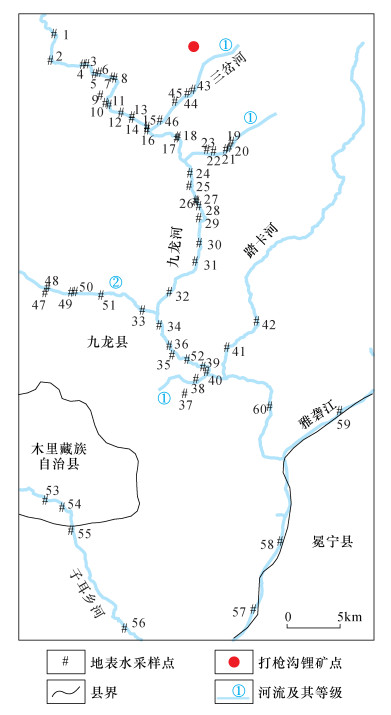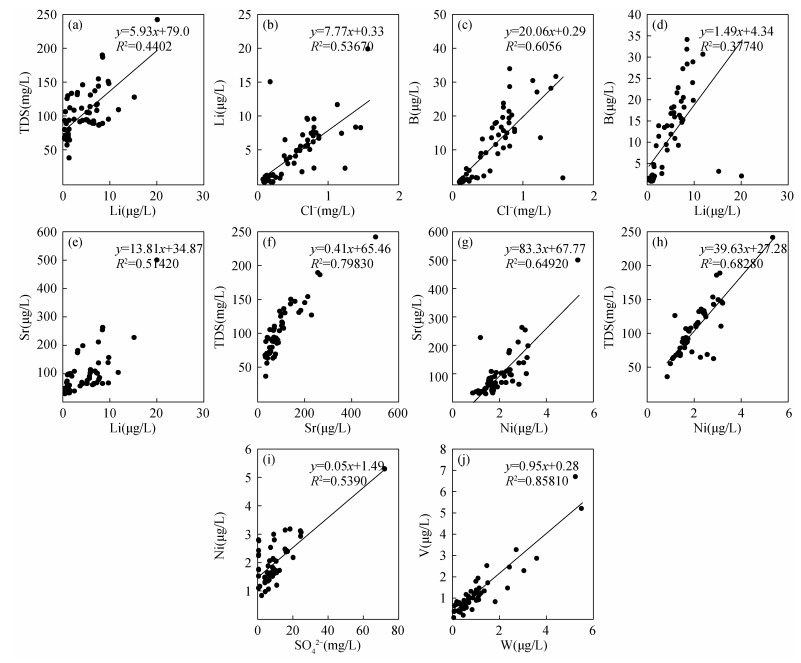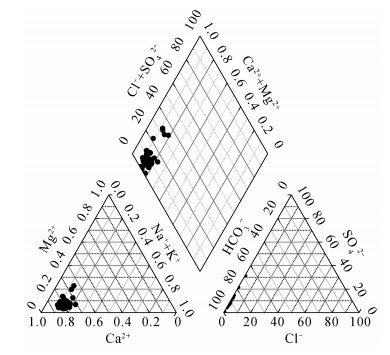Hydrochemical Prospecting and Its Application in Green Investigation for the Large Mineral Resource Base: A Case Study from Jiulong Area in Western Sichuan Province
-
摘要:
“战略性新兴产业矿产调查”工程积极倡导绿色调查新理论新方法在大型资源基地勘查开发中的应用,绿色调查是川西大型锂铍资源基地综合调查评价工作的主要内容之一。本文梳理了水化学找矿法的发展历程与现状,提出了水化学找矿法应用于矿产勘查及环境调查评价中存在的主要问题。在川西九龙湿润半湿润高寒山区,尝试应用水化学找矿法对地表水中的化学异常进行研究,初步阐明应进一步详细调查的锂远景区。实验方法是在野外现场运用多参数测试仪测定地表水的温度(T)、pH值、电导率(EC)、溶解氧(DO)、总溶解性固体(TDS)五个参数,结合电感耦合等离子体质谱法(ICP-MS)测定锂硼铷锶镍钨钪等微量元素,进而分析水体元素含量特征与矿化的关系。结果表明:研究区水体中的锂硼锶镍含量明显高于背景值,在采集的60件样品中,17%的样品以上微量元素含量超过异常下限(7.76μg/L),其中流经乌拉溪岩体东南角(石头沟)的水体锂含量达到最大值20.1μg/L,是研究区水体锂含量背景值的4.5倍,是异常下限的2.6倍,与矿化的关系密切,其明显的变化规律可作为水化学找锂的找矿标志。研究区内乌拉溪岩体东南部及洛莫岩体周边水体水化学异常与矿化关系明显,可作为下一步详细调查的远景区。研究认为,在当前环境保护战略地位不断提升、绿色勘查力度持续加大、资源调查与环境保护并重的现实条件下,水化学方法对前期找矿部署有指导意义。研究成果为解决川西高原生态脆弱区找矿部署与环境保护等实际问题提供了参考依据。
-
关键词:
- 水化学找矿 /
- 锂 /
- 电感耦合等离子体质谱法 /
- 大型资源基地 /
- 绿色调查
Abstract:BACKGROUND The 'Strategic Emerging Industry Mineral Investigation' project actively advocates the application of new theories and methods of green investigation in the exploration and development of large-scale resource bases. Green investigation is one of the main content of the comprehensive investigation and evaluation work of large-scale lithium and beryllium resource bases in western Sichuan.
OBJECTIVES To summarize the development history and current situation of the hydrochemical prospecting method, and the main problems of the hydrochemical prospecting method in mineral exploration and environmental investigation are put forward. To preliminarily elucidate the lithium prospect area which should be further investigated in details, by using hydrochemical prospecting method in the humid and semi-humid alpine mountainous area of Jiulong, West Sichuan.
METHODS The temperature, pH value, electrical conductivity, dissolved oxygen and total dissolved solids (TDS) of surface water were measured by field multi-parameter tester. The content of trace elements such as Li, B, Rb, Sr, Ni, W and Sc were determined by inductively coupled plasma-mass spectrometry (ICP-MS).
RESULTS The content of lithium, boron, strontium and nickel in the water body of the study area was significantly higher than the background value. Among the 60 samples, more than 17% of the samples had content of trace elements in excess of the abnormal lower limit (7.76μg/L). The lithium content of the water body flowing through the southeast corner of the Wulaxi rock mass (Shitougou) reached the maximum value of 20.1μg/L, which was 4.5 times the background value of the water body lithium content in the study area and 2.6 times the abnormal lower limit. These anomalies were closely related to mineralization, and its obvious change law can be used as a hydrochemical lithium search prospecting sign. The southeastern part of the Wulaxi pluton and the surrounding water body of the Lomo Pluton had an obvious relationship with mineralization, which can be used as a prospective area for the next detailed investigation.
CONCLUSIONS Under the current conditions of continuous improvement of the strategic position of environmental protection, continuous increase of green exploration efforts, and equal emphasis on resource investigation and environmental protection, hydrochemical methods have important guiding significance for early prospecting deployment. The research results provide a reference for solving practical problems such as prospecting deployment and environmental protection bottlenecks in the ecologically fragile areas of the Western Sichuan Plateau.
-

-
表 1 水样中部分微量元素含量特征
Table 1. Characteristics of trace elements contents in water samples
分析项目 Li Ni Sr W V B 最大值(μg/L) 20.1 5.40 505 5.53 6.80 35.0 最小值(μg/L) 0 0.80 31.0 0.05 0.10 1.0 平均值(μg/L) 2.90 1.90 79.0 0.68 1.00 6.0 标准离差 4.00 0.70 78.0 1.09 1.10 10.0 富集系数 0.19 0.08 0.43 1.07 0.02 0.53 变异系数 0.90 0.38 0.80 1.05 0.89 0.89 背景值(μg/L) 4.50 2.0 97.0 1.04 1.30 11.0 异常下限(μg/L) 7.76 2.80 141 1.47 1.77 20.8 数据个数(个) 60 60 60 60 60 60 表 2 研究区水体中主要溶解性离子含量
Table 2. Main soluble ions content in water system
分析项目 离子含量(mg/L) Ca2+ Mg2+ Na+ K+ Cl- SO42- HCO3- F- 最大值 66.8 13.7 6.12 11.0 1.57 72.8 171 0.63 最小值 11.0 0.76 0.56 0.74 0.09 0.05 38.7 0.03 平均值 28.3 3.15 2.19 2.64 0.54 9.16 99.8 0.14 标准离差 9.07 2.59 1.21 1.33 0.38 10.4 29.50 0.11 参考值 0.78 0.38 0.3 0.3 0 1.5 7.8 - 注:参考值为常见花岗岩地区的天然河流主要溶质浓度[45]。 表 3 研究区水环境因子特征
Table 3. Characteristics of environmental factors of water in the study area
统计项目 温度(℃) pH 电导率(μS/cm) 溶解氧(mg/L) TDS (mg/L) 最大值 22.70 8.70 387.00 8.22 245 最小值 9.60 7.31 61.80 6.82 38.6 平均值 15.65 8.24 168.02 7.46 100 标准离差 3.15 0.24 56.82 0.36 35.9 -
[1] [1] 王登红, 王瑞江, 付小方, 等. 对能源金属矿产资源基地调查评价基本问题的探讨——以四川甲基卡大型锂矿基地为例[J]. 地球学报, 2016, 37(4): 471-480. doi: 10.3975/cagsb.2016.04.09
Wang D H, Wang R J, Fu X F, et al. A discussion on the major problems related to geological investigation and assessment for energy metal resources base: A case study of the Jiajika large lithium mineral resource base[J]. Acta Geoscientica Sinica, 2016, 37(4): 471-480. doi: 10.3975/cagsb.2016.04.09
[2] 王登红, 刘善宝, 于扬, 等. 川西大型战略性新兴产业矿产基地勘查进展及其开发利用研究[J]. 地质学报, 2019, 93(6): 1444-1453. doi: 10.3969/j.issn.0001-5717.2019.06.020
Wang D H, Liu S B, Yu Y, et al. Exploration progress and development suggestion for the large-scale mining base of strategic critical mineral resources in western Sichuan[J]. Acta Geologica Sinica, 2019, 93(6): 1444-1453. doi: 10.3969/j.issn.0001-5717.2019.06.020
[3] 王伟, 刘图强, 袁蔺平, 等. 川西九龙黄牛坪铍矿床地质特征及找矿潜力[J]. 中国地质调查, 2019, 6(6): 72-78. https://www.cnki.com.cn/Article/CJFDTOTAL-DZDC201906009.htm
Wang W, Liu T Q, Yuan L P, et al. Geological characteristics and prospecting potential of Huangniuping beryllium deposit in Jiulong of West Sichuan[J]. Geological Survey of China, 2019, 6(6): 72-78. https://www.cnki.com.cn/Article/CJFDTOTAL-DZDC201906009.htm
[4] 杨少平. 关于水地球化学测量的回顾和思考[J]. 物探与化探, 2008, 32(1): 13-18. https://www.cnki.com.cn/Article/CJFDTOTAL-WTYH200801004.htm
Yang S P. A review and some considerations of water geochemical survey[J]. Geophysical & Geochemical Exploration, 2008, 32(1): 13-18. https://www.cnki.com.cn/Article/CJFDTOTAL-WTYH200801004.htm
[5] 地质部水文地质研究所. 水化学找矿的基本原理及方法[J]. 地质月刊, 1959(1): 13-17. https://www.cnki.com.cn/Article/CJFDTOTAL-DIZI195901009.htm
Institute of Hydrogeology, Ministry of Geology. Basic principles and methods of hydrochemical prospecting[J]. Geological Monthly, 1959(1): 13-17. https://www.cnki.com.cn/Article/CJFDTOTAL-DIZI195901009.htm
[6] 陈扬. 谈谈利用水化学作为找矿标志的几个问题[J]. 水文地质工程地质, 1958(2): 43-46. https://www.cnki.com.cn/Article/CJFDTOTAL-SWDG195802010.htm
Chen Y. Discussions about using water chemistry as a prospecting indicator[J]. Hydrogeology and Engineering Geology, 1958(2): 43-46. https://www.cnki.com.cn/Article/CJFDTOTAL-SWDG195802010.htm
[7] 309地质队. 云南某铅矿水化学测量工作初步总结[J]. 地质与勘探, 1960(7): 11-14. https://www.cnki.com.cn/Article/CJFDTOTAL-DZKT196007004.htm
No. 309 Geological Team. A preliminary summary of the hydrochemical measurement of a lead mine in Yunnan[J]. Geology and Prospecting, 1960(7): 11-14. https://www.cnki.com.cn/Article/CJFDTOTAL-DZKT196007004.htm
[8] 康继本, 吴承烈, 李善芳. 略论综合地质普查工作中分散流与水化学找矿方法的作用及其合理应用[J]. 地质学报, 1961, 41(2): 175-185. https://www.cnki.com.cn/Article/CJFDTOTAL-DZXE196102005.htm
Kang J B, Wu C L, Li S F. A discussion on the function and reasonable application of dispersed flow and hydrochemical prospecting methods in comprehensive geological survey[J]. Chinese Journal of Geology, 1961, 41(2): 175-185. https://www.cnki.com.cn/Article/CJFDTOTAL-DZXE196102005.htm
[9] 李善芳, 康继本. 地球化学探矿方法在地质测量中的作用及若干技术问题[J]. 中国地质, 1962(增刊1): 37-43. https://www.cnki.com.cn/Article/CJFDTOTAL-DIZI1962Z1004.htm
Li S F, Kang J B. The role of geochemical prospecting methods in geological survey and some related technical issues[J]. Geology in China, 1962(Supplement 1): 37-43. https://www.cnki.com.cn/Article/CJFDTOTAL-DIZI1962Z1004.htm
[10] 叶正祥, 魏泉海. 放射性水化学找矿方法[J]. 原子能科学技术, 1962(5): 340-343. https://www.cnki.com.cn/Article/CJFDTOTAL-YZJS196205002.htm
Ye Z X, Wei Q H. Radioactive water chemical prospecting method[J]. Atomic Energy Science and Technology, 1962(5): 340-343. https://www.cnki.com.cn/Article/CJFDTOTAL-YZJS196205002.htm
[11] 刘金河. 水化学稀网度普查方法及应用效果[J]. 放射性地质, 1984(3): 41-47. https://www.cnki.com.cn/Article/CJFDTOTAL-YKDZ198403006.htm
Liu J H. Methods and application effect of the sparse net survey of hydrochemistry[J]. Uranium Geology, 1984(3): 41-47. https://www.cnki.com.cn/Article/CJFDTOTAL-YKDZ198403006.htm
[12] 杜海燕. 联合国教科文地球化学找矿方法训练班[J]. 地质科技情报, 1986(1): 67. https://www.cnki.com.cn/Article/CJFDTOTAL-DZKQ198601019.htm
Du H Y. United nations educational and scientific geochemical prospecting method training course[J]. Geological Science and Technology Information, 1986(1): 67. https://www.cnki.com.cn/Article/CJFDTOTAL-DZKQ198601019.htm
[13] 张景廉. 利用矿物溶液平衡的铀的水化学找矿方法[J]. 放射性地质, 1983(5): 19, 85-90. https://www.cnki.com.cn/Article/CJFDTOTAL-YKDZ198305011.htm
Zhang J L. Hydrochemical prospecting method of uranium using mineral solution balance[J]. Uranium Geology, 1983(5): 19, 85-90. https://www.cnki.com.cn/Article/CJFDTOTAL-YKDZ198305011.htm
[14] 杜龙明. 放射性水化学测量在铀矿地质区域调查中的应用效果[J]. 铀矿地质, 1987(1): 53-59. https://www.cnki.com.cn/Article/CJFDTOTAL-YKDZ198701006.htm
Du L M. Application effect of radioactive water chemical survey in uranium mine geological survey[J]. Uranium Geology, 1987(1): 53-59. https://www.cnki.com.cn/Article/CJFDTOTAL-YKDZ198701006.htm
[15] 黄际能. 大富岭铀矿床放射性水化学数据处理方法及其找矿效果[J]. 华东地质学院学报, 1989, 12(4): 48-57. https://www.cnki.com.cn/Article/CJFDTOTAL-HDDZ198904006.htm
Huang J N. Radioactive hydrochemical data processing techniques used in Dafuli uranium deposit and the ore prospecting effects[J]. Journal of East China College of Geology, 1989, 12(4): 48-57. https://www.cnki.com.cn/Article/CJFDTOTAL-HDDZ198904006.htm
[16] 朱基忠, 陈仁祥. 隘高岩体地下水的放射性特征及其找矿效果[J]. 铀矿地质, 1990(2): 85-92. https://www.cnki.com.cn/Article/CJFDTOTAL-YKDZ199002004.htm
Zhu Z J, Chen R X. Radioactive characteristics of groundwater in Aigao rock mass and its prospecting effect[J]. Uranium Geology, 1990(2): 85-92. https://www.cnki.com.cn/Article/CJFDTOTAL-YKDZ199002004.htm
[17] 毛秀茹. 水化学找金新方法的现状和展望[J]. 黄金, 1990(12): 8-15. https://www.cnki.com.cn/Article/CJFDTOTAL-HJZZ199012002.htm
Mao X R. The current situation and vista of hydrochemical prospect for gold[J]. Gold, 1990(12): 8-15. https://www.cnki.com.cn/Article/CJFDTOTAL-HJZZ199012002.htm
[18] 郭三民. 陕西葫芦沟地区水文地球化学找金研究[J]. 黄金地质科技, 1993(1): 38-43. https://www.cnki.com.cn/Article/CJFDTOTAL-HJDZ199301006.htm
Guo S M. Researches on gold exploration by hydrochemical methods in Hulugou Area in Shaanxi Province[J]. Gold Geology, 1993(1): 38-43. https://www.cnki.com.cn/Article/CJFDTOTAL-HJDZ199301006.htm
[19] 郭三民, 乔海明, 高改玲. 水化学找金试验研究[J]. 物探与化探, 1994(2): 97-103. https://www.cnki.com.cn/Article/CJFDTOTAL-WTYH402.002.htm
Guo S M, Qiao H M, Gao G L. Experimental research on explore gold by hydrochemical methods[J]. Geophysical and Geochemical Exploration, 1994(2): 97-103. https://www.cnki.com.cn/Article/CJFDTOTAL-WTYH402.002.htm
[20] 袁晓庆, 史维浚, 张卫民. 温暖潮湿地区金水文地球化学找矿方法探讨[J]. 华东地质学院学报, 1994, 17(2): 161-171. https://www.cnki.com.cn/Article/CJFDTOTAL-HDDZ402.008.htm
Yuan X Q, Shi W J, Zhang W M. Probe into the method of hydrogeochemical prospecting for gold in warm and moist areas[J]. Journal of East China Geological Institute, 1994, 17(2): 161-171. https://www.cnki.com.cn/Article/CJFDTOTAL-HDDZ402.008.htm
[21] 蒋敬业. 水化学找金方法述评[J]. 地质科技情报, 1998, 7(1): 98-103. https://www.cnki.com.cn/Article/CJFDTOTAL-DZKQ801.019.htm
Jiang J Y. Review of the method of hydrogeochemical exploration gold[J]. Geological Science and Technology Information, 1998, 7(1): 98-103. https://www.cnki.com.cn/Article/CJFDTOTAL-DZKQ801.019.htm
[22] 刘崇民. 隐伏矿的地球化学找矿方法技术研究[J]. 物探与化探, 1993, 17(6): 474-475. https://www.cnki.com.cn/Article/CJFDTOTAL-WTYH199306011.htm
Liu C M. Research on geochemical prospecting methods and technology of hidden ore[J]. Geophysical and Geochemical Exploration, 1993, 17(6): 474-475. https://www.cnki.com.cn/Article/CJFDTOTAL-WTYH199306011.htm
[23] 蒋敬业, 谭大芳, 柴红年, 等. 水化学方法在区域化探异常评价中的应用研究[J]. 地质科技情报, 1999, 18(3): 104-108. doi: 10.3969/j.issn.1000-7849.1999.03.024
Jiang J Y, Tan D F, Chai H N, et al. Application of hydrochemical method in appraising regional geochemical anomaly[J]. Geological Science and Technology Information, 1999, 18(3): 104-108. doi: 10.3969/j.issn.1000-7849.1999.03.024
[24] 马生明, 朱立新, 周国华, 等. 高山峡谷区快速评价找矿靶区的化探方法技术[J]. 物探与化探, 2002, 26(3): 185-191. doi: 10.3969/j.issn.1000-8918.2002.03.005
Ma S M, Zhu L X, Zhou G H, et al. Geochemical techniques for rapid appraisal of ore prospecting targets in high mountain and canyon areas[J]. Geophysical & Geochemical Exploration, 2002, 26(3): 185-191. doi: 10.3969/j.issn.1000-8918.2002.03.005
[25] Simpson P R, Edmunds W M, Breward N, et al. Geochemical mapping of stream water for environmental studies and mineral exploration in the UK[J]. Journal of Geochemical Exploration, 1993, 49(1-2): 63-88. doi: 10.1016/0375-6742(93)90039-O
[26] Yue S, Wang G. Relationship between the hydrogeochemical environment and sandstone-type uranium mineralization in the Ili Basin, China[J]. Applied Geochemistry, 2011, 26: 133-139. doi: 10.1016/j.apgeochem.2010.11.010
[27] Mazzucchelli R H. The Frederick Project: Geochemical exploration for sediment-hosted base metals in covered terrain in the Bangemall Basin, western Australia[J]. Geochemistry: Exploration, Environment, Analysis, 2012, 12: 257-264. doi: 10.1144/geochem2011-107
[28] Benabdelkader A, Taleb A, Probst J L, et al. Anthropogenic contribution and influencing factors on metal features in fluvial sediments from a semi-arid Mediterranean River Basin (Tafna River, Algeria): A multi-indices approach[J]. Science of the Total Environment, 2018, 626: 899-914. doi: 10.1016/j.scitotenv.2018.01.107
[29] 辛至秀. 运用放射性水化学方法寻找隐伏铀矿体[J]. 世界核地质科学, 2012, 29(2): 92-98. doi: 10.3969/j.issn.1672-0636.2012.02.006
Xin Z X. The exploration of buried uranium ore bodies by hydrochemical radioactive method[J]. World Nuclear Geoscience, 2012, 29(2): 92-98. doi: 10.3969/j.issn.1672-0636.2012.02.006
[30] 林效宾, 李西得, 邹耀林, 等. 二连盆地铀矿床放射性水文地球化学异常特征研究[J]. 世界核地质科学, 2017, 34(2): 80-86. doi: 10.3969/j.issn.1672-0636.2017.02.003
Lin X B, Li X D, Zou Y L, et al. Study on radioactive hydrogeochemical characteristics in uranium deposit of Erlian Basin[J]. World Nuclear Geoscience, 2017, 34(2): 80-86. doi: 10.3969/j.issn.1672-0636.2017.02.003
[31] 杨安林, 王太平. 铀矿水文地球化学找矿方法在找矿中的应用[J]. 地下水, 2018, 40(5): 149-150. doi: 10.3969/j.issn.1004-1184.2018.05.052
Yang A L, Wang T P. Application of hydrogeological prospecting method for uranium ore in prospecting[J]. Ground Water, 2018, 40(5): 149-150. doi: 10.3969/j.issn.1004-1184.2018.05.052
[32] 王刚, 邵东, 陈云杰, 等. 甘肃省龙首山成矿带放射性水文地质特征浅析[J]. 东华理工大学学报(自然科学版), 2018, 41(3): 236-243. doi: 10.3969/j.issn.1674-3504.2018.03.005
Wang G, Shao D, Chen Y J, et al. Analysis on the characteristics of radioactive hydrogeology in the Longshoushan metallogenic belt of Gansu Province[J]. Journal of East China University of Technology (Natural Science), 2018, 41(3): 236-243. doi: 10.3969/j.issn.1674-3504.2018.03.005
[33] 王太平, 杨安林. 安康地区采集地表溪水作为铀矿水化学找矿可行性研究[J]. 地下水, 2018, 40(5): 102-104. doi: 10.3969/j.issn.1004-1184.2018.05.037
Wang T P, Yang A L. Feasibility study on collecting surface water from Ankang Area as uranium ore chemical prospecting[J]. Ground Water, 2018, 40(5): 102-104. doi: 10.3969/j.issn.1004-1184.2018.05.037
[34] Gray J E, Goldfarb R J, Detra D E, et al. Geochemistry and exploration criteria for epithermal cinnabar and stibnite vein deposits in the Kuskokwim River Region, southwestern Alaska[J]. Journal of Geochemical Exploration, 1991, 41: 363-386. doi: 10.1016/0375-6742(91)90009-J
[35] Graham G E, Taylor R D, Lee G K, et al. Targeting Cu-Au and Mo resources using multi-media exploration geochemistry: An example from Tyonek Quadrangle, Alaska Range, Alaska[J]. Journal of Geochemical Exploration, 2015, 157: 52-65. doi: 10.1016/j.gexplo.2015.05.014
[36] Manning A H, Morrison J M, Wanty R B, et al. Using stream-side groundwater discharge for geochemical exploration in mountainous terrain[J]. Journal of Geochemical Exploration, 2020, 209: 106415. doi: 10.1016/j.gexplo.2019.106415
[37] Hamilton S M, Cameron E M, McClenaghan M B, et al. Redox, pH and SP variation over mineralization in thick glacial overburden. Part Ⅰ: Methodologies and field investigation at the Marsh Zone gold property[J]. Geochemistry: Exploration, Environment, Analysis, 2004, 4: 33-44. doi: 10.1144/1467-7873/03-020
[38] Hamilton S M, Cameron E M, McClenaghan M B, et al. Redox, pH and SP variation over mineralization in thick glacial overburden. Part Ⅱ: Field investigation at Cross Lake VMS property[J]. Geochemistry: Exploration, Environment, Analysis, 2004, 4: 45-58. doi: 10.1144/1467-7873/03-021
[39] Marie-Eve Caron, Stephen E, Grasby M, et al. Spring water trace element geochemistry: A tool for resource assessment and reconnaissance mineral exploration[J]. Applied Geochemistry, 2008, 23: 3561-3578. doi: 10.1016/j.apgeochem.2008.07.020
[40] Noble R R P, Anand R R, Gray D J, et al. Metal migra-tion at the DeGrussa Cu-Au sulphide deposit, western Australia: Soil, vegetation and groundwater studies[J]. Geochemistry: Exploration, Environment, Analysis, 2017, 17: 124-142. doi: 10.1144/geochem2016-416
[41] Hulkki H, Taivalkoski A, Lehtonen M. Signatures of Cu-Au mineralisation reflected in inorganic and heavy mineral stream sediments at Vähäkurkkio, north-western Finland[J]. Journal of Geochemical Exploration, 2018, 188: 156-171. doi: 10.1016/j.gexplo.2018.01.012
[42] Taivalkoski A, Sarala P, Lahaye Y, et al. Snow in mineral exploration- examples and practices in glaciated terrain[J]. Journal of Geochemical Exploration, 2019, 200: 1-12. doi: 10.1016/j.gexplo.2019.01.006
[43] 马生凤, 温宏利, 许俊玉, 等. 电感耦合等离子体质谱法测定地下水中44个元素[J]. 岩矿测试, 2010, 29(5): 552-556. doi: 10.3969/j.issn.0254-5357.2010.05.016 http://www.ykcs.ac.cn/article/id/ykcs_20100516
Ma S F, Wen H L, Xu J Y, et al. Determination of 44 elements in groundwater by inductively coupled plasma-mass spectrometry[J]. Rock and Mineral Analysis, 2010, 29(5): 552-556. doi: 10.3969/j.issn.0254-5357.2010.05.016 http://www.ykcs.ac.cn/article/id/ykcs_20100516
[44] 阎葆瑞, 张锡根. 湘粤地区几个多金属矿床水的某些地球化学特征[J]. 中国地质, 1962(1): 21-26. https://www.cnki.com.cn/Article/CJFDTOTAL-DIZI196201003.htm
Yan B R, Zhang X Y. Some geochemical characteristics of water in several polymetallic deposits in Hunan and Guangdong Area[J]. Chinese Geology, 1962(1): 21-26. https://www.cnki.com.cn/Article/CJFDTOTAL-DIZI196201003.htm
[45] 陈静生. 河流水质原理与中国河流水质[M]. 北京: 科学出版社, 2006.
Chen J S. Principles of river water quality and river water quality in China[M]. Beijing: Science Press, 2006.
-




 下载:
下载:


